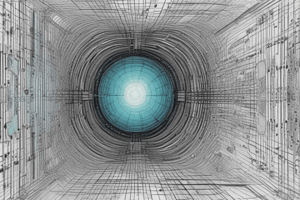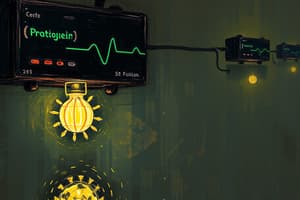Podcast
Questions and Answers
What is a key feature of a strain gauge?
What is a key feature of a strain gauge?
- It measures temperature changes.
- It converts mechanical strain into an electrical signal. (correct)
- It converts electrical energy into mechanical work.
- It functions only with liquid materials.
Which type of potentiometer provides a good visual indication of its setting?
Which type of potentiometer provides a good visual indication of its setting?
- Rotary potentiometer
- Membrane potentiometer
- Linear potentiometer (correct)
- Strain gauge potentiometer
In a membrane potentiometer, what is the resistance range it can change between?
In a membrane potentiometer, what is the resistance range it can change between?
- 1 Ohm to 100 Ohms
- 100 Ohms to 10,000 Ohms (correct)
- 1 kOhm to 1 MOhm
- 10 Ohms to 1000 Ohms
Which materials can be used to construct a potentiometer?
Which materials can be used to construct a potentiometer?
What is a typical application of a strain gauge?
What is a typical application of a strain gauge?
What is the main function of electric motors in electric actuators?
What is the main function of electric motors in electric actuators?
What role do control electronics play in electric actuators?
What role do control electronics play in electric actuators?
Which application commonly uses electric actuators?
Which application commonly uses electric actuators?
What is the primary function of sensors?
What is the primary function of sensors?
What type of sensor measures the temperature of an environment?
What type of sensor measures the temperature of an environment?
What does signal conditioning involve?
What does signal conditioning involve?
Which type of sensing principle changes based on the measured quantity's capacitance?
Which type of sensing principle changes based on the measured quantity's capacitance?
What is transduction in the context of sensor technology?
What is transduction in the context of sensor technology?
What types of output signals are used in mechatronic systems?
What types of output signals are used in mechatronic systems?
What does the output signal format depend on?
What does the output signal format depend on?
How do actuators convert signals into motion?
How do actuators convert signals into motion?
What power source do pneumatic actuators utilize?
What power source do pneumatic actuators utilize?
Which of the following is a key advantage of hydraulic actuators?
Which of the following is a key advantage of hydraulic actuators?
What type of movement can an actuator’s output mechanism produce?
What type of movement can an actuator’s output mechanism produce?
What is a common application of pneumatic actuators?
What is a common application of pneumatic actuators?
What role do hydraulic pumps and valves play in hydraulic actuators?
What role do hydraulic pumps and valves play in hydraulic actuators?
Flashcards are hidden until you start studying
Study Notes
Overview of Output Signals
- Output signals can be analog, digital, or pulse signals.
- They are transmitted in formats like voltage, current, frequency, or pulse width.
- The specific actuator and its requirements determine the signal format.
- Actuators interpret received signals and convert them into mechanical motion or changes in physical properties.
Introduction to Output Actuators
- Mechanical parts include gears, shafts, and linkages.
- Actuators translate electrical or fluid energy into motion.
- Actuators have internal control systems that regulate speed, position, or force based on input signals.
- Output mechanisms can be linear (straight line movement) or rotary (circular movement).
Hydraulic Actuators
- They utilize hydraulic fluid and pressure to generate force and motion.
- Hydraulic pumps and valves control the pressure.
- High force output, smooth and precise motion, and ease of control are advantages.
- Applications include construction equipment, heavy machinery, and aerospace systems.
Pneumatic Actuators
- They use compressed air as their power source.
- Air is supplied by air compressors and controlled by valves.
- Known for their fast response time and ability to move quickly.
- Cleanliness is an advantage, suitable for environments where contamination is a concern.
- Applications include automated assembly lines, packaging machinery, and robotics.
Electric Actuators
- They utilize electric motors as their power source.
- Motors convert electrical energy into rotational or linear motion.
- Control electronics manage the motor's speed, torque, and direction.
- They are typically integrated with the motor for precise control.
- Advantages include precision, efficiency, and low maintenance, making them widely used in automation, robotics, and consumer products.
Introduction to Sensors
- Sensors detect and measure physical quantities from the environment.
- They convert physical quantities into electrical signals.
Types of Sensors
- Temperature sensors measure the temperature of an object or environment.
- Pressure sensors measure the force per unit area applied to a surface.
- Motion sensors detect movement or changes in position.
- Light sensors measure the intensity or color of light.
Sensor Technology Fundamentals
- Transduction: Converting physical quantities into electrical signals.
- Signal Conditioning: Amplifying, filtering, and converting signals to a usable format.
- Data Processing: Analyzing and interpreting sensor data.
Sensing Principles
- Resistive Sensing: Changes in resistance based on the measured quantity.
- Capacitive Sensing: Changes in capacitance based on the measured quantity.
- Inductive Sensing: Changes in inductance based on the measured quantity.
Passive Transducers - Resistance
- Potentiometer: A variable resistor used to measure position or angle.
- Rotary potentiometer: Has a resistive element connected between terminals 1 and 3, with a wiper connected to terminal 2.
- Linear potentiometer: Has a linear slider with a wiper sliding along a linear resistive element, providing visual indication of its setting.
- Membrane potentiometer: Very thin linear variable potentiometers, allowing for precise calculations of relative position.
- Strain Gauge: Converts mechanical strain into an electrical signal.
- Consists of a wire or foil patterned in a zigzaga that is attached to the material being observed.
- Deformation of the gauge alters its electrical resistance, which is proportional to the applied strain.
- Used for measuring strain due to stress in load cells, torque meters, diaphragms, accelerometers, and flow meters.
- Thermistor: A semiconductor device that exhibits a change in resistance with temperature.
- Thermocouple: A device that generates an electrical voltage proportional to the temperature difference between two dissimilar metals.
Studying That Suits You
Use AI to generate personalized quizzes and flashcards to suit your learning preferences.




